Does State Testing Help or Hurt Science Education?
By Leena Bakshi, CSTA Secretary, Peter A’Hearn, CSTA President-Elect and Tricia Dennis
“Wow, are you really asking that?”
“You know you’re going to get a lot of opinions on that one.”
“Are you sure you want people to answer that?”
CSTA and the STEM4Real team put this question up at the CSTA booth at the CA STEAM Symposium in Anaheim last December. We hoped the poster would get people interested in visiting our booth and start some discussions. We had no idea. As you can see, we received hundreds of responses and had some very rich discussions.
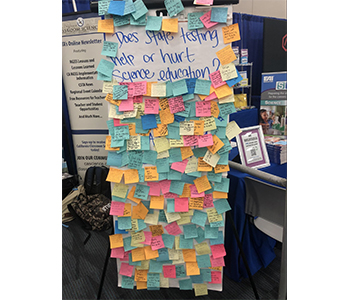
We would love for you to submit your answer to the question - Does State Testing Help or Hurt Science Education.
Click here.
When we asked the question, we had no idea that testing would be cancelled by a global pandemic. At the time all state testing, including science testing, was mandated by the Federal government. With the future of testing in question, it might be a good time to ask some hard questions about testing and where we might go from here.
So how did people respond?
We received answers from a wide variety of people involved in science and STEM education. Plenty of classroom teachers at all grade levels, students, administrators, publisher representatives, and even item writers for state tests.
Most responded that state tests are hurtful for science education. 63% of responses concluded that testing hurt science education in some way. This is because it takes away time and resources are diverted away from teaching “good” science. And the focus is towards preparing students for an assessment. As one person noted, “we are creating a generation of test takers versus critical thinkers.” Teachers were spending more time teaching to the test and learning about test preparation for students.
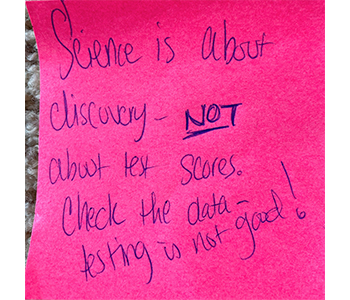
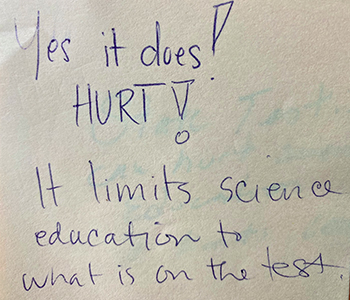
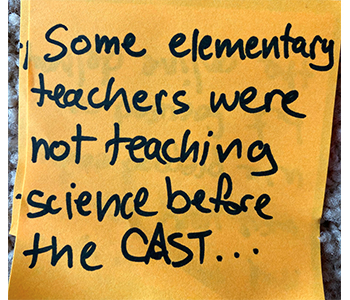
According to the California Department of Education, “(It is) imperative to avoid making important educational decisions based on a single test result.” Yet, in practice, many school and district leaders use high stakes measures such as state assessment data to inform funding found in Local Control and Accountability Plans (LCAPs), and Single Plans for Student Achievement (SPSAs).
One teacher summed up state testing as stressful and painful for students, teachers and families. The high stakes of state testing take the joy out of experiential learning, as several teachers noted. Other teachers said that they feel their creativity in teaching is stifled. Many felt that state testing measures yield unfair and inequitable results, especially to diverse student groups such as English Language Learners, Students with Special Needs, and Black and Latinx students. Also, state testing is computer-based, further emphasizing the digital divide that exists among students and teachers that do not have the computer literacy necessary to navigate the test. We are seeing this digital divide further stratified as we transition to virtual learning in the wake of the COVID-19 pandemic.
11% thought tests were helpful. The main reason for this was that it helps focus attention and time on science. Without a science test, one administrator admitted, there would be no science teaching happening at their school. People who thought tests were helpful noted that tests help teachers to align to the new standards and help focus instruction on what’s important. Testing provides accountability and ensures rigor.
Those who pointed out that testing helps put a focus on science, realize that science education oftentimes takes a backseat to its familiar counterparts, mathematics and English-language arts. These two subject areas are also tested yearly starting from 3rd grade onwards. Therefore, many educators take their priorities directly from the assessment pressures of state testing. The CAST carved its way into the assessment world when it became “operational” for the first time in 2019. With preliminary results released, science leaders hoped for the necessary jolt that it would give school and district administrators in order to start prioritizing science instruction, and with that, science funding. Despite 63% of the educators surveyed agreed that state testing hurts science instruction overall, other responses illustrated that the presence of an accountability measure in science makes science education more relevant in schools.
Having an assessment devoted to science helps ensure that science will not only be taught, but it will be prioritized as a core subject. There has been an increased effort to thoughtfully choose instructional materials for science and allocate necessary funding for professional learning dedicated to science education. The additional accountability measure places the necessary checks and balances for both teachers and administrators to ensure that science is taught and adequate instructional minutes are allocated for science. The onset and implementation of the CA Next Generation Science Standards (CA-NGSS) further shifted science reform efforts by placing emphasis on the doing and thinking of science and away from rote memorization of isolated science facts. Some respondents noted that having an assessment for these standards have increased the rigor for science, especially for high-needs populations such as students with special needs and English Language Learners. Ultimately, the assessment places science education on the radar of school and district administrators that dictate curriculum and instruction efforts.
Without the test and accountability, will science education still remain a priority in education? State assessments in science can provide leverage for schools and districts to mandate necessary instructional minutes for science, funding allocation for materials, and resources for a robust science education. Will this continue without data from state testing?
The rest of the responses were in between, accounting for 24% of the responses. “Testing is a double edged sword.” “Testing is useful if we have better tests.” These people acknowledged that testing has problems but felt it had benefits as well. Some respondents had mixed feelings about state testing because of this. Assessment serves as a way to make science education relevant and necessary. Some responses were able to recognize both the pros and cons of state testing. Others wanted to see an improvement in state testing that could truly measure student growth and achievement.
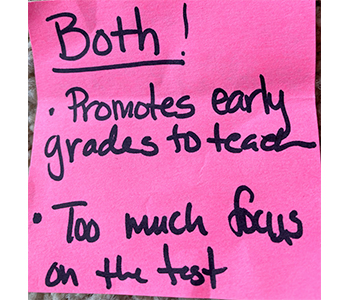

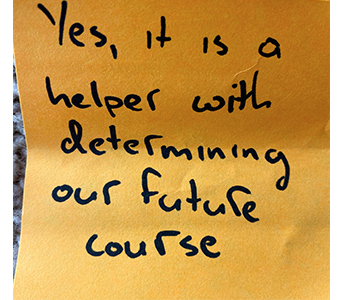
Since the majority see the current system of high stakes testing as deeply flawed, the pause in testing might mean it’s time to reevaluate the whole system. The National Research Council wrote a report on “Developing Assessments for the NGSS,” that envisions a much richer system of assessment that provides better guidance for teaching. These include assessing the opportunity to learn: is there quality curriculum, facilities, teacher training, and resources? They also envision a system of classroom embedded assessment that provides rich and timely feedback to teachers on student learning.
Some have pointed out that one of the worst things about the current Federally mandated testing system is that it requires individual student and teacher scores instead of giving a statistical score to schools and districts. If we didn’t have to score every student, then every student wouldn’t need to be tested on every standard, and tests could be much shorter and less burdensome.
We are now living in a time where federally mandated testing for 2020 in all subject areas is on pause. It’s time to ask ourselves, “Can NGSS-aligned instruction truly happen without a test AND from a distance?” In the face of a global pandemic, our teachers have had to shift gears completely. They serve on the frontlines for our students and their importance is further underscored. Science and STEAM education are a vital part of our core education, especially as our society comes together during these uncharted times. The necessity for understanding STEM has taken on greater importance in this time of a global pandemic. From understanding of exponential growth, to using technology to map out the COVID-19 outbreak, to engineering ventilators, and to ultimately understanding the science of contagion, viruses and outbreaks, we see science education as a way to stand united as educators and as a community for our students.
These are the opinions of the authors and not positions of the California Science Teachers Association. CSTA has official policies on both accountability and assessment.
- Position Statement on Science Accountability Systems -
- Position Statement on Assessing Student’s Knowledge and Understanding of Science





